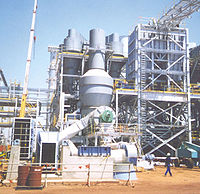Difference between revisions of "Centrifugally Agitated Bed Dryers"
Jump to navigation
Jump to search
PurplePen19 (talk | contribs) |
|||
| Line 7: | Line 7: | ||
* Please start editing this page after the /noinclude | * Please start editing this page after the /noinclude | ||
* -------------------------------------------------></noinclude> | * -------------------------------------------------></noinclude> | ||
[[File:Centrifugally Agitated Bed Dryers.jpg|thumb|200px|right|Centrifugally Agitated Bed Dryers]] | [[File:Centrifugally Agitated Bed Dryers.jpg|thumb|200px|right|Centrifugally Agitated Bed Dryers]] | ||
Through the '''Centrifugally Agitated Bed Dryers''', the material begins to act like a fluid with gas of the right velocity passed though the bed. There is excellent solids/gas contact, resulting in high heat transfer rates for rapid drying. The | |||
drying capacity can be up to 300 tph. | |||
==Centrifugally Agitated Bed Dryers are suitable for:== | |||
* Sands (Mineral & Foundry) | * Sands (Mineral & Foundry) | ||
* Minerals (Limestone, Magnetite, Gypsum, Copper, Salt, Iron Ore) | * Minerals (Limestone, Magnetite, Gypsum, Copper, Salt, Iron Ore) | ||
| Line 23: | Line 21: | ||
* Well agitated | * Well agitated | ||
* High capacity | * High capacity | ||
==Concept of the Centrifugally Agitated Bed Dryers== | |||
The bed has the appearance of a vigorously boiling liquid, and in fact the bed of material takes on many of the properties of a fluid. It exerts a hydrostatic head, and the material will flow through a hole in the vessel or over and under a weir within the bed. | The bed has the appearance of a vigorously boiling liquid, and in fact the bed of material takes on many of the properties of a fluid. It exerts a hydrostatic head, and the material will flow through a hole in the vessel or over and under a weir within the bed. | ||
Latest revision as of 22:13, 19 August 2012
Through the Centrifugally Agitated Bed Dryers, the material begins to act like a fluid with gas of the right velocity passed though the bed. There is excellent solids/gas contact, resulting in high heat transfer rates for rapid drying. The drying capacity can be up to 300 tph.
Centrifugally Agitated Bed Dryers are suitable for:
- Sands (Mineral & Foundry)
- Minerals (Limestone, Magnetite, Gypsum, Copper, Salt, Iron Ore)
- Plant Seeds & Grains (Grass, Wheat, Oats)
- Chemical Mixtures Main benefits of the Centrifugally Agitated Bed Dryers:
- Ability to dry small to fine material
- Low maintenance
- Well agitated
- High capacity
Concept of the Centrifugally Agitated Bed Dryers
The bed has the appearance of a vigorously boiling liquid, and in fact the bed of material takes on many of the properties of a fluid. It exerts a hydrostatic head, and the material will flow through a hole in the vessel or over and under a weir within the bed.
